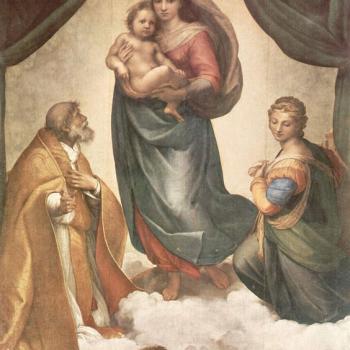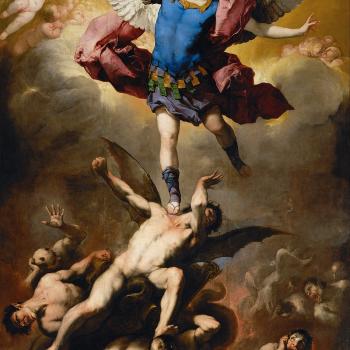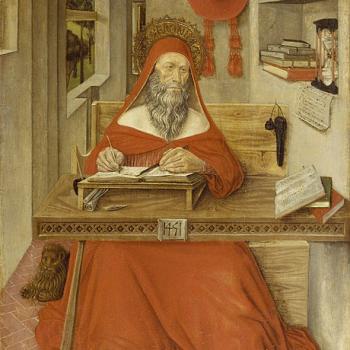
Fr. William Saunders, in one of his consistently excellent articles for The Arlington Catholic Herald (12-19-13), wrote:
St. Luke related the announcement of the birth of St. John the Baptist to his elderly parents, St. Zechariah and St. Elizabeth. St. Zechariah was a priest of the class of Abijah (Lk 1:5), the eighth class of 24 priestly classes (Neh 12:17). Each class served one week in the temple, twice a year.
Josef Heinrich Friedlieb has established that the priestly class of Abijah would have been on duty during the second week of the Jewish month Tishri, the week of the Day of Atonement or in our calendar, between Sept. 22 and 30. While on duty, the Archangel Gabriel informed Zechariah that he and Elizabeth would have a son (Lk 1:5-24). Thereupon, they conceived John, who after presumably 40 weeks in the womb would have been born at the end of June. For this reason, we celebrate the Nativity of St. John the Baptist June 24.
St. Luke also recorded how the Archangel Gabriel told Mary that Elizabeth was six months pregnant with John (Lk 1:36), which means the Annunciation occurred March 25, as we celebrate. Nine months from March 25, or six months from June 24, renders the birth of Christ at Dec. 25, our Christmas.
Marty Barrack adds:
Shemaryahu Talmon, Professor Emeritus in the Bible Department at Hebrew University in Jerusalem and a top Scroll scholar, in 1958 published an in-depth study of the Temple’s rotating assignment of priests [1 Chr 24:7] [Dave: see 1 Chr 24:10; cf. 24:1-19] and the Qumran scrolls to see the assignment during New Testament times. It shows definitively that Zachariah served as a Temple priest [Lk 1:8] in September. His wife, St. Elizabeth, conceived late in September, as the archangel Gabriel said, [Lk 1:24] and afterward remained in seclusion for five months. Church tradition is that her son John the Baptizer was conceived on September 23.
It’s commonly believed (I have thought this myself) that Christians made the date of Christmas to correspond to Roman holidays, so as to wipe them out. Fr. Saunders observed:
The Romans did celebrate Saturnalia between Dec. 17 and 23, commemorating the winter solstice Dec. 23, but Christmas does not fit that time frame. What about the “Birthday of the Unconquered Sun” [Natalis Solis Invicti or Sol Invictus] Dec. 25?
He goes on to note that we have a record of celebrations of Christmas on December 25th, from Pope St. Telesphorus (c. 125-136), the seventh bishop of Rome, St. Theophilus (AD 115-181), bishop of Caesarea, St. Hippolytus (170-240), Pope Liberius (352-66), St. Gregory Nazianzus (d. 389), and St. Ambrose (d. 397). The Romans celebrated the winter solstice on December 25th in the Julian calendar. At length, he concludes: “Christmas was celebrated Dec. 25 prior to any pagan celebration on the same date.” The earliest date provided by historical evidence, for the Roman celebration of Sol Invictus is 274 (institution by the Roman emperor Aurelian).
In his book, The Spirit of the Liturgy (Ignatius Press, revised edition, 2000), Pope Benedict XVI explains:
The claim used to be made that December 25 developed in opposition to the Mithras myth, or as a Christian response to the cult of the unconquered sun promoted by Roman emperors in the third century in their efforts to establish a new imperial religion. However, these old theories can no longer be sustained. (pp. 107-108)
Catholic Answers apologist Jon Sorensen adds:
That the Christians chose a date so close to the winter solstice is also not proof that this was done to mimic pagan festivals. The various pagan religions all had festivals spanning the calendar. Whatever month the early Christians might have otherwise chosen would still place Christmas near some pagan celebration, and oppositional theorists would still be making the same claims. (“Why December 25?”, Catholic Answers, 12-16-13)
Andrew McGowan (no insignificant scholar) wrote in an article for Bible Review (Dec. 2002; reprinted in Bible History Daily, 12-3-17):
[E]arly Christian writers never hint at any recent calendrical engineering; they clearly don’t think the date was chosen by the church. Rather they see the coincidence as a providential sign, as natural proof that God had selected Jesus over the false pagan gods.
It’s not until the 12th century that we find the first suggestion that Jesus’ birth celebration was deliberately set at the time of pagan feasts. A marginal note on a manuscript of the writings of the Syriac biblical commentator Dionysius bar-Salibi states that in ancient times the Christmas holiday was actually shifted from January 6 to December 25 so that it fell on the same date as the pagan Sol Invictus holiday. In the 18th and 19th centuries, Bible scholars spurred on by the new study of comparative religions latched on to this idea. They claimed that because the early Christians didn’t know when Jesus was born, they simply assimilated the pagan solstice festival for their own purposes, claiming it as the time of the Messiah’s birth and celebrating it accordingly. . . .
From the mid-fourth century on, we do find Christians deliberately adapting and Christianizing pagan festivals. A famous proponent of this practice was Pope Gregory the Great, who, in a letter written in 601 C.E. to a Christian missionary in Britain, recommended that local pagan temples not be destroyed but be converted into churches, and that pagan festivals be celebrated as feasts of Christian martyrs. At this late point, Christmas may well have acquired some pagan trappings. But we don’t have evidence of Christians adopting pagan festivals in the third century, at which point dates for Christmas were established. Thus, it seems unlikely that the date was simply selected to correspond with pagan solar festivals.
Photo credit: The Visitation, by Philippe de Champaigne (1602-1674) [public domain / Wikimedia Commons]
***













